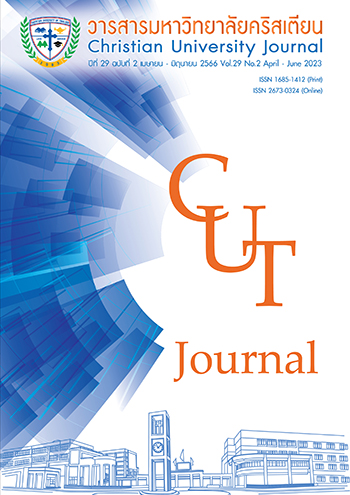The Antimicrobial Efficiency of Liquid Soap Mixed Pomelo Peel Extracts Planting in Nakhon-pathom Province
Keywords:
Liquid soap, Pomelo peel extracts, Antimicrobial activityAbstract
This research aimed to study the yield and physical properties of pomelo peel extracts from hydro-distillation method of Thong-dee and Khao-nahm-peung varieties. Then, the antimicrobial activity of the extracts were tested against Escherichia coli and Staphylococcus aureus by agar disc diffusion method. Moreover, liquid soap mixed pomelo peel extracts was developed to reduce the chemical agents in antimicrobial activity product.
Results indicated that the pomelo peel extracts of Thong-dee and Khao-nahm-peung varieties by hydro-distillation method showed the similar physical properties. However, the extracted yield of Khao-nahm-peung varieties was higher than Thong-dee varieties equal to 1.167 and 0.936 %W/W respectively and no significant difference. The results of antimicrobial activity showed no difference between the both varieties of pomelo peels extracts at concentration of 40 mg/ml against both bacteria species. Furthermore, the antimicrobial activity of liquid soap mixed pomelo peel extracts of Khao-nahm-peung varieties at concentration of 40 mg/ml was significantly more effective than liquid soap without extracts (p<0.05). Thus, this developed product can inhibit the growth of bacteria.
References
กรมส่งเสริมการเกษตร กระทรวงเกษตรและสหกรณ์. (2560). สถานการณ์การปลูกส้มโอ ปี 2559 เรียงตามเนื้อที่ปลูกจากมากไปน้อยรายจังหวัด. สืบค้นจาก http://www.agriinfo.doae.go.th/year60/plant/rortor/fruit2/pomelo.pdf
ประกาศกระทรวงสาธารณสุข เรื่อง กำหนดวัตถุกันเสียที่อาจใช้เป็นส่วนผสมในการผลิตเครื่องสำอาง พ.ศ. 2561 (2561, 19 ตุลาคม). ราชกิจจานุเบกษา. เล่ม 135 ตอนพิเศษ 363 ง, หน้า 18-22.
ปรียานุช กฤษณะประสิทธิ์ และ พรทิพย์ จึงถาวรรณ. (2552). ศึกษาฤทธิ์ต้านเชื้อของสารสกัดจากส้มต่อจุลินทรีย์ที่ทำให้อาหารเน่าเสียและจุลินทรีย์ที่ทำให้เกิดโรค. (วิทยานิพนธ์ปริญญามหาบัณฑิต). มหาวิทยาลัยมหิดล, กรุงเทพมหานคร.
พัชราภรณ์ ฐิติวงศ์เศวต, เสาวลักษณ์ วงษ์จันลา และวิจิตร จันดาวงศ์. (2559). สบู่ต้านเชื้อแบคทีเรียจากสารสกัดหยาบจากผลมะขามป้อม. วารสารมหาวิทยาลัยศรีนครินทรวิโรฒ (สาขาวิทยาศาสตร์และเทคโนโลยี), 8(15), 27-39.
วัชรินทร์ รังสีภาณุรัตน์, พัชรี กัมมารเจษฎากุล และ อิสยา จันทร์วิทยานุชิต. (2559). ฤทธิ์ของสารสกัดสมุนไพรไทย 10 ชนิด ต่อการยับยั้งเชื้อแบคทีเรีย Staphylococcus aureus ATCC 25923, Bacillus cereus และ Escherichia coli ATCC 25922. วารสารมหาวิทยาลัยหัวเฉียวเฉลิมพระเกียรติวิชาการ, 19(38), 35-48.
Abirami, A., Nagarani, G., & Siddhuraju, P. (2013). Antimicrobial activity of crude extract of Citrus hystrix and Citrus maxima. International Journal of Pharmaceutical Sciences and Research, 4(1), 296-300.
Bora, H., Kamle, M., Mahato, D. K., Tiwari, P., & Kumar, P. (2020). Citrus essential oils (CEOs) and their applications in food: An overview. Plants, 9(3), 357. doi: 10.3390/plants9030357.
Dosoky, N. S., & Setzer, W. N. (2018). Biological activities and safety of Citrus spp. essential oils. International Journal of Molecular Sciences, 19(7), 1966. doi: 10.3390/ijms19071966.
Hongpattarakere, T., Chanthachum, S., & Chanthaphon, S. (2008). Antimicrobial activities of essential oils and crude extracts from tropical Citrus spp. against food-related microorganisms. Songklanakarin Journal of Science and Technology, 30, 125-131.
McNamara, P. J., & Levy, S. B. (2016). Triclosan: An instructive tale. Antimicrobial Agents and Chemotherapy, 60(12), 7015-7016. doi: 10.1128/AAC.02105-16.
Obi, C. N. (2014). Antibacterial activities of some medicated soaps on selected human pathogens. American Journal of Microbiological Research, 2(6), 178-181. doi: 10.12691/ ajmr-2-6-3.
Phat, D. T., Tuyen, K. C., Huynh, X. P. & Truc, T. T. (2020). Extraction process optimization and characterization of the pomelo (Citrus grandis L.) peel essential oils grown in Tien Giang Province, Vietnam. Natural Volatiles and Essential Oils, 7(4), 26-33. doi: 10.37929/nveo.780505.
Shan, B., Cai, Y. Z., Brooks, J. D., & Corke, H. (2007). The in vitro antibacterial activity of dietary spice and medicinal herb extracts. International Journal of Food Microbiology, 117(1), 112–119.
Sir Elkhatim, K. A., Elagib, R. A., & Hassan, A. B. (2018). Content of phenolic compounds and vitamin C and antioxidant activity in wasted parts of Sudanese citrus fruits. Food Science & Nutrition, 6(5), 1214–1219. doi: 10.1002/fsn3.660.
Wang, C. F. & Tian, Y. (2015). Reproductive endocrine-disrupting effects of triclosan: Population exposure, present evidence and potential mechanisms. Environmental Pollution, 206, 195-201. doi: 10.1016/j.envpol.2015.07.001.
Weatherly, L. M. & Gosse, J. A. (2017). Triclosan exposure, transformation, and human health effects. Journal of Toxicology and Environmental Health, Part B, 20(8), 447-469. doi: 10.1080/10937404.2017.1399306.
Witorsch, R. J. (2014). Critical analysis of endocrine disruptive activity of triclosan and its relevance to human exposure through the use of personal care products. Critical Reviews in Toxicology, 44(6), 535–555. doi: 10.3109/10408444.2014.910754.
Yueh, M. F. & Tukey, R. H. (2016). Triclosan: A widespread environmental toxicant with many biological effects. Annual Review of Pharmacology and Toxicology, 56, 251-272. doi: 10.1146/annurev-pharmtox-010715-103417.
Downloads
Published
Issue
Section
License
Copyright (c) 2023 Christian University of Thailand

This work is licensed under a Creative Commons Attribution-NonCommercial-NoDerivatives 4.0 International License.


